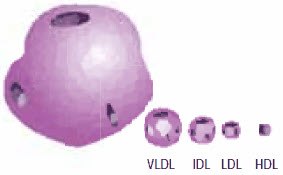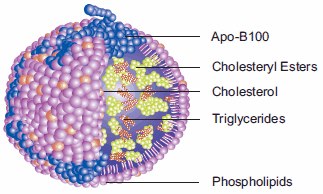Cholesterol Transport
Since cholesterol is a water-insoluble molecule it must be packaged for transport within the plasma. The particles that package cholesterol, cholesteryl esters, and triglycerides for transport, are called lipoproteins. There are five main classifications of lipoproteins based on their size and density. The higher the ratio of protein to lipid content the higher the density.
The largest and least dense lipoproteins are chylomicrons (Figure 1). Chylomicrons predominately transport triacylglycerols to adipose tissue and muscle as fatty acids, but also deliver dietary cholesterol taken up by enterocytes in the lumen to the liver. Once most of the triacylglycerols have been delivered to the adipose tissue and muscle, the remnants of the lipoprotein, including cholesterol, apoE, and apo-B48 are then delivered to, and taken up by, the liver through interaction with the chylomicron remnant receptor.

Figure 1.Chylomicron.
The largest and least dense lipoproteins are chylomicrons (Figure 1). Chylomicrons predominately transport triacylglycerols to adipose tissue and muscle as fatty acids, but also deliver dietary cholesterol taken up by enterocytes in the lumen to the liver. Once most of the triacylglycerols have been delivered to the adipose tissue and muscle, the remnants of the lipoprotein, including cholesterol, apoE, and apo-B48 are then delivered to, and taken up by, the liver through interaction with the chylomicron remnant receptor.

Figure 2.Low Density Lipoprotein.
Very low density lipoproteins (VLDL) are smaller and more dense than chylomicrons (Figure 2). VLDLs contain triacylglycerols, some cholesterol and cholesteryl esters and the apoproteins; apo- B100, apo-CI, apo-CII, apo-CIII, and apoE. VLDLs exist to remove triacylglycerols and cholesteryl esters from the liver and distribute them throughout the body. As VLDLs move into the circulating plasma they are converted first to intermediate density lipoproteins (IDL) and then into low density lipoproteins (LDL). Lipoprotein lipase serves to remove the majority of fatty acids from both the VLDL and IDL, thus increasing the density of the lipoproteins while maintaining cholesterol and cholesteryl ester concentrations. The removal of fatty acids and the loss of all apolipoproteins except apoB-100 and apo(a) results in LDL. LDLs are the primary plasma carriers of cholesterol for delivery to all tissues. LDL can be absorbed by the liver and other tissues via receptor mediated endocytosis.

Figure 3.LDL Receptor.
The cytoplasmic domain of the LDL receptor facilitates the formation of coated pits; receptor-rich regions of the membrane. The ligand binding domain of the receptor recognizes apo-B100 on LDL, resulting in the formation of a clathrin-coated vesicle that buds from the inner surface of the cell membrane (Figure 3). ATP-dependent proton pumps lower the pH inside the vesicle resulting in dissociation of LDL from its receptor. After loss of the clathrin coat, the vesicles fuse with lysozomes resulting in peptide and cholesteryl ester enzymatic hydrolysis. The LDL receptor can be recycled to the cell membrane. Insulin, triiodothyronine, and dexamethasone have been shown to affect the regulation of LDL receptor mediated endocytosis.
High density lipoproteins (HDL) are the smallest of the lipoproteins and most dense. HDL contains several types of apolipoproteins including apo-AI, II & IV, apo-CI, II & III, apoD and apoE. HDL contains mostly protein, phospholipids, cholesteryl esters, and cholesterol. HDL is produced as a protein rich particle in the liver and intestine, and serves as a circulating source of Apo-CI & II and ApoE proteins. The HDL protein particle accumulates cholesteryl esters by the esterification of cholesterol by lecithin:cholesterol acyl-transferase (LCAT). LCAT is activated by apo-AI on HDL. HDL can acquire cholesterol from cell membranes and can transfer cholesteryl esters to VLDL and LDL via the transferase activity of apoD. HDL can return to the liver where cholesterol is removed by reverse cholesterol transport, thus, serving as a scavenger of free cholesterol.
Apolipoprotein Composition of Lipoproteins |
|---|
如要继续阅读,请登录或创建帐户。
暂无帐户?